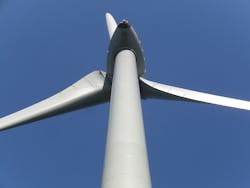Renewable Microgrids Get Boost from Extension of U.S. Tax Credits
Credit: Ian Prowell
Congress gave a boost to renewable microgrids last week with a multi-year extension of tax credits for solar, wind and other distributed energy resources (DER).
The credits were part of a $1.1 trillion omnibus budget and tax extender package approved by the House and Senate and quickly signed by President Barack Obama.
Generation often represents a large portion of a microgrid’s development costs, and the generation portion of a microgrid has been difficult, at times, to finance. Not all microgrids generate their power with renewable energy, but an increasing number do.
Developers of renewable microgrids cheered the vote.
“Schneider Electric is very happy to hear about the extension of the credits as, renewables are critical to our clients’ microgrid projects,” said Philip Barton, Schneider Electric’s microgrid and DER program director. “Increasingly, our projects include inverter based distributed energy resources, nearly all of which are helped by incentives.”
Sahm White, economic & policy analysis director for the Clean Coalition, said that the tax credits, along with other favorable tax treatment approved by Congress, “will clearly support the cost savings basis for exponential growth in development of microgrids.”
The other favorable tax treatment includes extension of a bonus depreciation for property and expansion of what is known as Section 179, a part of the Internal Revenue Service tax code that lets businesses deduct the full price of certain equipment the year that it’s purchased.
The solar and wind tax credits were set to expire or diminish without Congressional action. The credits – especially when extended for multiple years – have been a large boon to renewable energy growth, according to the Solar Energy Industries Association and the American Wind Energy Association.
Supporters of the credits argue that they remain necessary because renewables are not cost-competitive with grid power in all states yet.
“These applications are just reaching the critical cost effectiveness threshold in many settings, and the expiration of the investment tax credit at this time would have delayed this for at least four years, slowing our progress in improving grid resiliency, local reliability, and reduced emissions, just as nations have agreed to historic commitments on addressing climate concerns,” White said.
The vote means that solar will see a continuation of its 30 percent tax credit through 2019, when it starts to decline, reaching 10 percent by 2022. Wind power will continue its full 2.3 cents/kWh tax credit until 2017 when it ramps down to 80 percent, reaching 40 percent in 2019.
GTM Research estimates that renewable microgrids will grow more than tenfold in the U.S. by 2020. Overall, generation accounts for about 40 percent of the money spent on a microgrid, according to the research firm.
The House approved the spending plan 316-113 and Senate 65-33. The budget and tax extender legislation represented a rare bipartisan compromise in a Congress that is often gridlocked. The renewable energy tax credits won approval after Democrats agreed to support an end to a 40-year ban on oil exports.
Read more about renewable microgrids by subscribing to the free Microgrid Knowledge newsletter.
About the Author
Elisa Wood
Editor-in-Chief
Elisa Wood is the editor and founder of EnergyChangemakers.com. She is co-founder and former editor of Microgrid Knowledge.
